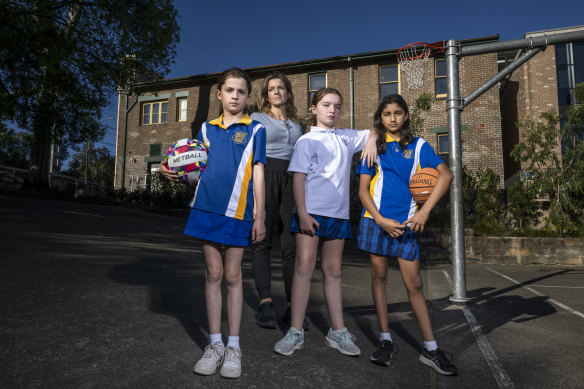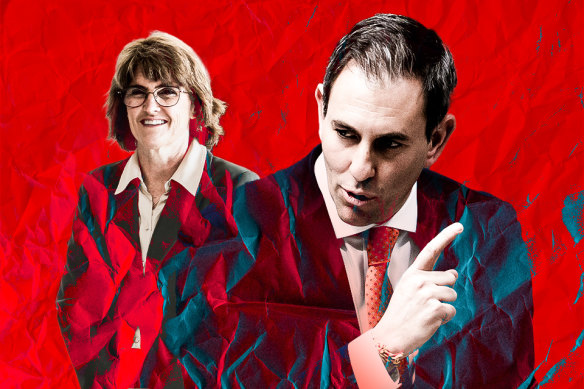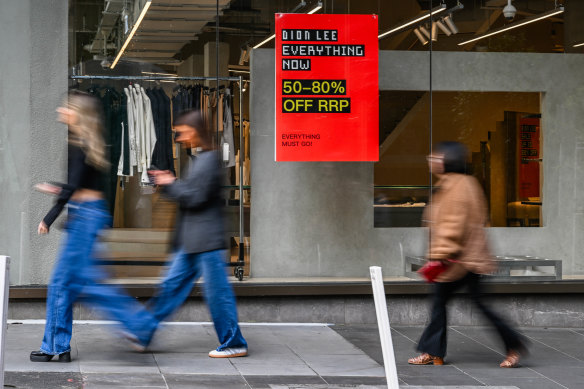The demise of primary school sport and the lack of choices in both primary and high school should be resisted by all members of the community (“Public schools forced to halt sport as gap grows”, September 4). Participation in school sport gives young children an opportunity to sample a range of activities, which often leads to lifelong involvement not only as a player but as a coach, referee or volunteer, thus benefiting the wider community. Engagement in sport takes kids away from the phone and promotes better fitness and diet, again of benefit to all. The future of community sports organisations depends on young players coming through, something that will diminish as sport is downgraded by the education system. Teachers, too, will miss the opportunity to engage with students at a level other than the classroom, which often enhances behaviour and learning. The government needs to step up and fund school sport or face the consequences which will surely come in the future.
Peter Cooper-Southam, Frenchs Forest

Haylee Kerans with Summer Hill Public school students at the basketball court at Darrell Jackson Gardens. Credit: Louise Kennerley
It’s not the public schools that are killing off sport, it’s our tolerance of, or more correctly, our support of, inequality in education that’s doing the damage. In a country where quality decisions have been made about equality of access to education, this story wouldn’t exist, but decades of failure to do so by successive governments of all persuasions have delivered us the current situation where private schools compete to provide excessively luxurious, state-of-the-art facilities, while public schools eke out every dollar on necessities. Prue Nelson, Cremorne Point
The spotlight on elite sport, especially the Olympics, can shift the focus away from the key role played by grassroots sport both at community and school levels. There are many variables; transport costs, training facilities, provision of sporting grounds and the old chestnut of who pays the bills - especially for ovals where local councils have costs to be met. Graham Windeatt broke the world record for the 800-metre freestyle in 1971 at North Sydney Olympic Pool, swimming in the Combined High Schools Swimming Championships. This performance is a poignant reminder of why school sport counts and we as a society need to find a mechanism to better support sport at the grassroots level. Rod Leonarder, Roseville
I’m a retired teacher with 45 years experience in both public and private school systems. Inequality in sport opportunities leads to inequality in overall education, which leads to vocational inequalities, social inequalities, increased crime, costs and a downward spiral. Sport, to me as a student and as a teacher, were the most memorable and engaging opportunities I experienced. Education should be viewed as an investment, not an expenditure. Many of the problems in rural communities are the result of the demise of sport in schools, between schools and within communities. Bruce Jacob, Carlingford
When I finally settled into public schooling in 4th class, playing and the group travel home on Friday evenings with the rugby league and cricket squads were right up there with my week’s highlights. These were part of the curriculum to me, trying to belong, starting long-term friendships, liking school and just being happy. By 6th class I was school vice-captain, our sports master and coach relied on me to manage and report any misbehaviour on public transport. Never a bad report was made, these were an assortment of unprivileged kids from the west of Sydney who loved their sport and Friday afternoons. Brian Jones, Leura
Stick with ‘steady’ Jim
Blaming Jim Chalmers for the economic conditions is rich (“Sharp yet blunt, Chalmers takes punt on rift with RBA”, September 4). There have been difficult pandemic and post-pandemic conditions. High inflation, low economic growth and low unemployment together are abnormal. Coalition claims are contrived, dishonest and cynical, and only for advantage.
Addressing inflation impacts means squeezing already low growth. If inflation is from an overheated economy, addressing it cuts growth, but from a high base, which isn’t the luxury now. It’s not easy. The underlying numbers aren’t as bad as the headline numbers. Chalmers has been a steady hand, clearly superior to the alternative in Angus Taylor with his sorry record as energy minister. Nick Wilson, Palm Beach

RBA Governor Michele Bullock and Treasurer Jim Chalmers.Credit: Aresna Villanueva
The social psychologist Hugh Mackay’s mantra: to compete successfully, focus on your customers, not your competitors (“Albanese faces his toughest test”, September 4). This is not just applicable to Albo but all companies as well. The Labor government has many media advisors. Surely, these veteran media advisors collectively can come up with a strategy about how to sell the government message about the tax cuts, electricity bills and so on. A recent survey found that people have no idea what benefits the government has given to voters. This is the government’s biggest challenge. Mukul Desai, Hunter Hill
Those decrying the apparent “timidity” of the Albanese government need to remember what happened to Bill Shorten and the bold and innovative manifesto he took to the 2019 election. These people who appear hungry for ideological purity should also heed the words of that supremely successful ALP politician, Neville Wran, whose advice to Bob Hawke prior to the 1983 election was, “If the greedy bastards wanted spiritualism, they’d join the f---ing Hare Krishnas. Give ’em a tax cut!” Albanese may have his faults, but he knows what it takes to win elections. Grant Heaton, Port Macquarie
I hate to admit it, but Labor is struggling. Voters do not care about the RBA. Chalmers needs to focus on what Labor can do to help day-to-day economic life, particularly for low-income earners. Measures such as increasing the low-income tax offset, increasing childcare subsidies and introducing a means-tested home loan tax offset would go a long way in correcting the position. Time is running out. Michael Blissenden, Dural
The correspondence about “rusted-on voters” reminded me of how my father patiently explained that all politicians should be voted out after four election cycles (Letters, September 4). He reasoned that they became inured to the plight of the poor, they begin to believe they deserve the largesse and power they receive plus they end up owing too many favours to others, including lobbyists and factional allies. In other words, they became self-serving instead of serving the electorate. In all my time following politics, only the great Ted Mack appeared to not prove Dad’s observation to be a truism. Andrew Brown, Bowling Alley Point
I read Ned Manning’s column with sadness and a sinking feeling of agreement and recognition. The young people that I know, including my children, seem not only disillusioned and some have even completely lost interest. There’s an election looming but where is the vision, courage, and actually caring about voters from any of the parties? Tatiana Podmore, Cremorne
Reflecting on Gauguin
Rowan Godwin’s letter about Paul Gauguin has again stirred my interest in how history has treated the artist and his artworks (Letters, September 4). When I first saw them in Papeete, Tahiti, I was completely moved and mesmerised by the blank, sad and troubled faces of the young women depicted. Gauguin’s own journals cite the “charms of Polynesian women” and the “idyllic” surroundings. By his own admission, many of these were underage girls. Everyone has a choice of what they define as art, but for me, the faces of the women in many of his works beckons deeper consideration by art patrons. Peter O’Brien, Shoalhaven Heads
Captive tigers’ instinct
A woman was bitten by a tiger at Dreamworld this week (“‘Experienced’ Dreamworld handler attacked while walking tiger”, September 3). Such attacks are common and inevitable. The 47-year-old woman, said to be “experienced”, is suffering from multiple lacerations and puncture wounds to her arm.
Captive tigers are still bound to follow their instincts. Such confrontations – which occur with staggering regularity – show that these animals experience profound levels of stress, anxiety and agitation. Captivity is a living hell for them and denies them the opportunity to engage in any of the activities that give their lives meaning. No animal can thrive in such an artificial and traumatic environment.
Entertainment parks like Dreamworld don’t actually help to conserve endangered animals because those animals are almost never released. Those who are rarely fare well, since being reared in captivity leaves them ill-prepared to cope with life in the wild. Instead, they will be confined to cages and other man-made enclosures for their entire lives.
The best way to save animals from imprisonment is simply to stay away from facilities that display animals as living exhibits for humans to gawk at. We can protect endangered species by supporting habitat conservation, not animal prisons. Desmond Bellamy, Byron Bay

Dreamworld’s tigers at the theme park’s Tiger Island.
Support for mine shortsighted
It is rare to see any minister, under state or federal law, protect Aboriginal heritage in the face of a proposed mine (“Lies, damned lies and gold mines: What you need to know about the Blayney bunfight”, September 1). One would think that when Environment Minister Tanya Plibersek ruled that the Regis tailings dam must not affect Aboriginal heritage, the Aboriginal movement would loudly applaud her decision as a step in the right direction. Instead, Aboriginal groups have backed government and mining interests and condemned the minister. What a turnaround. The Regis mine debate has exposed the shortsightedness of some Aboriginal groups who, instead of building on Aboriginal gains made 40 years ago, such as the NSW Aboriginal Lands Act, now see those gains as the end of the road. Those lands really belong to our people, not the crown to issue development rights without Aboriginal consent. The land is sacred, whether it has been returned to us or not, as is the memory and knowledge of our people’s use and nurturing of the lands for millennia. If nothing else, Minister Plibersek’s decision, as small as it is, has flagged that development has to be balanced against the need to protect Aboriginal heritage. Michael Mansell, Launceston
Suits rule
The Liberal Party waxes and wanes between the concept of merit (Caucasian males in suits) and others (Letters, September 4). After every election, they promise to get some others but end up getting the suits. It would seem that with Dutton having his hand in the pre-selection process, nothing will change. Hopefully, from my point of view, nor will the government. John Rome Mt Lawley (WA)
Fast fashion
The main problem with buying Australian fashion is the price (“Love Australian fashion? Better buy some”, September 4). Melissa Singer asserts that the average Australian buys 56 items per year. The differences in cost means that for $1000, a person could buy three or four Australian-made items, or 56 overseas items. For Indigenous-made items the price rises even more. I have seen Australian-made items in the sale racks of country towns and still they are out of reach of ordinary Australians. Too many of our designer labels are for the very wealthy, which means that the rest of us have little choice in supporting them. If I see a well-made item for $20 compared with a similar item for $500, I know which one I will buy. Pamela Shepherd, Balgowlah

Australian fashion label Dion Lee will be wound up after failing to find a buyer.Credit: Joe Armao
Liberal dysfunction
Labor voters will be rejoicing that the NSW Liberals have been put into administration, led by two Victorians and a token NSW retiree - who has declined it (“NSW Liberals pushed into federal takeover after council fiasco”, September 4). Victoria is the very byword of Liberal dysfunction. Still, they could have asked Campbell Newman to lead it. Wayne Duncombe, Lilyfield
Not ready for takeoff
It is disappointing in the extreme to learn that the Minns government is not proceeding with a business case for connection of the new Western Sydney airport direct to a Metro West station at Westmead, let alone a fast rail service connecting Parramatta and Sydney (“More metro or heavy rail is new poser”, September 4). In my view, that is the single most important piece of public transport infrastructure to ensure the success of the new Western Sydney Airport. It is bad enough that the $11 billion orphan metro to St Mary’s has a different rolling stock gauge and traction system to the rest of the metro system, but to waste scarce funds on an extension to Tallawong just makes it worse. The fact is that within 20 kilometres of the new airport, the vast majority will use road-based transport. One really must wonder whether NSW wants Western Sydney Airport to be successful. Peter Thornton, Killara
Sydney now has no less than three types of single-deck rolling stock across its metropolitan basin: light rail, Metro and the forthcoming Western Sydney Airport Metro. Why this variation? I propose that we unstitch the confusion and revert to just two rail modes across Sydney by building the next generation of trains here in NSW. In Europe and parts of the US, there’s a type of single-deck train known commonly as a “tram-train”. Like the name suggests, these can do the job of both a tram and a train. They can stop and start as fast as a Metro, travel slower on roads, like a tram – and finally, as fast as a suburban heavy rail across longer trips. Why then, don’t we simply custom-build one type of “tram-train” to replace all Sydney’s other single-deck services vying for future projects?
This simple switch in thinking could end the current “incompatibility wars” that are mounting and become Jo Haylen’s sensible gift to an otherwise confused and likely overpriced Sydney rail network expansion. Nathan English, Balmain
The articles regarding the dearth of car parking near metro stations in the north-west seem to imply this is a recent phenomenon, dating from the opening of the extended metro service. Sadly, it has been this way for some time. The enormous population growth and poor public transport infrastructure around the Marsden Park area has led to a huge need to access transport into the CBD from Tallawong. Parking at Tallawong has been largely unavailable from at least 7am for some time, as with other parking areas nearby. There are on-call free bus services, but the eligible areas are very limited. Earlier this year I was quoted $90 for a three-kilometre trip to Tallawong at about 9 am. The metro is allowing much easier access to the city for those in the north-west. We need to solve the issue of how we can use it. Wendy Howard, Quakers Hill
Now $50 million must be spent each time a rail line extension is under discussion. Heavy rail or metro? That’s Gladys’ legacy of having started Sydney’s expensive metromania. When will that be stopped? The Western Sydney Airport may turn out to become a cargo port. For that we need heavy
rail, not metros. Matt Mushalik, Epping
Precious space
It was pleasing to see, this morning, that the large grass areas around the base of the Fleet Steps in Sydney’s Royal Botanical Garden are finally able to be used again, having been cordoned off all year while the grass recovers from the commercial operations of last summer (open air cinema and opera). Which means we have a little over one month before the area is once again closed off. Richard Tainsh, Potts Point
- To submit a letter to the Sydney Morning Herald, email letters@smh.com.au. Click here for tips on how to submit letters.
- The Opinion newsletter is a weekly wrap of views that will challenge, champion and inform. Sign up here.